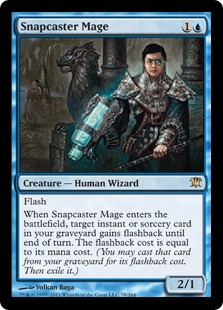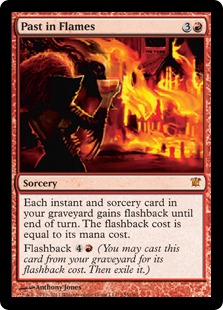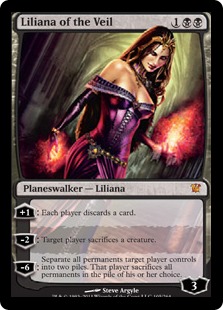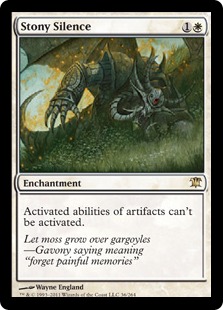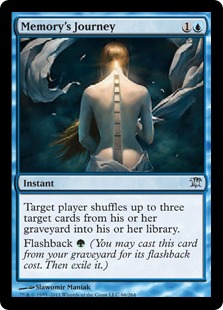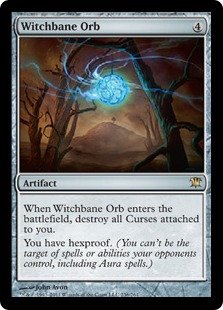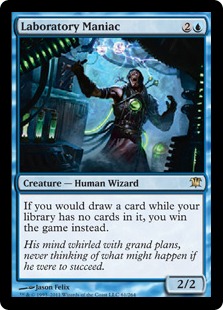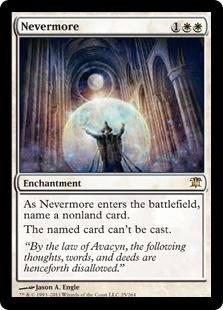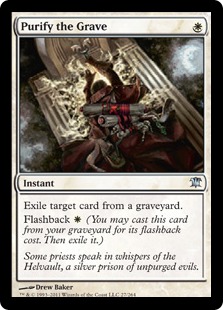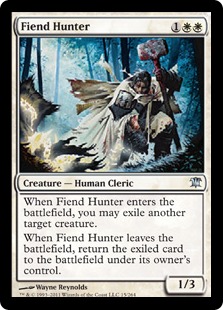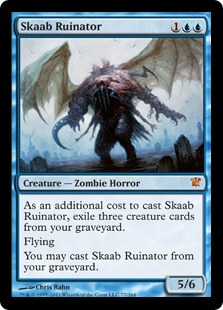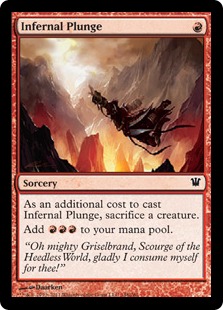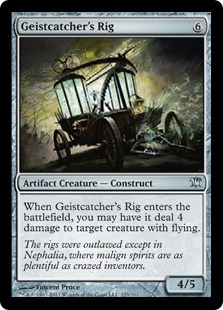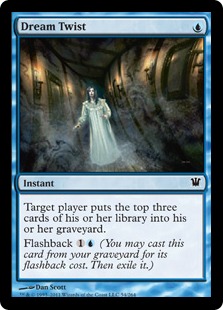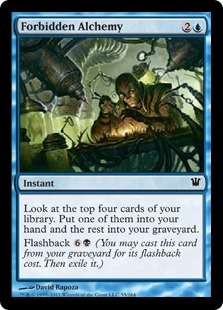Each fall, Wizards of the Coast graces the Magic community with another block, chock full of new and innovative cards to play with. While the Standard community typically benefits the most from the new set, which refreshes the metagame environment and introduces new mechanics and abilities to the mix, Eternal formats also benefit from the release of the new set. Some 95% of the new cards will inevitably be useless in Eternal formats, but that other 5% can usher in new strategies, as well as add new elements to existing ones that may put them over the top.
Innistrad, in particular, brings several cards to the table for Classic. As you would imagine, being a graveyard-oriented set, Innistrad offers new ways to interact with your and your opponent’s graveyards, something Classic decks are prime to take advantage of! Here’s a look at the most interesting cards that Innistrad will introduce to the Classic metagame when it is released in the client next week.
Let’s start with the card that just about everyone is excited about: Tiago Chan’s Invitational Card, Snapcaster Mage. It’s taken several years for this card to be released (the Invitational that Tiago won was back in 2007!), but it’s been well worth the wait! I’m not going to wax poetic about how this card is perhaps as good or better than another famous invitational card that Wizards made (Bob Maher’s Dark Confidant, aka “Bob”). Rather, I’d prefer to take a pragmatic view to see where Snapcaster fits into the Classic metagame in order to weigh its strengths and weaknesses.
Snapcaster Mage (“Tiago”) is all about value. Much like Bob, Snapcaster is best-viewed as a card that can incrementally help you win the game. Naturally, you are going to want to put Tiago into a deck that is playing a bunch of instants and sorceries to get maximum value from him. Unfortunately, the two best cards printed for those purposes are unavailable in Classic, Time Walk and Ancestral Recall. That’s not to say there aren’t a plethora of other cards that Tiago can flashback and swing the game’s momentum in your favor. The best decks to utilize Tiago are blue-based control decks. Here, cards like Brainstorm, Demonic Tutor, Vampiric Tutor, and countermagic are all excellent options to snapcast.
Starting with Brainstorm, which is perhaps the best draw spell available without access to Ancestral (with apologies to Gush), there are many prime draw spells that Tiago can target. Classic players also typically use Gitaxian Probe, which can still be cast with its Phyrexian mana cost instead of using a blue mana. Preordain and Ponder also see varying amounts of Classic play. Gush, on the other hand is not an ideal target for Tiago since you cannot use Gush‘s alternative cost to flash it back, the alternative cost being Gush’s salient feature.
The best tutors in the game are all restricted, and for good measure. Having the ability to cast a Demonic Tutor more than once in a game would make it awfully hard to lose, yet Snapcaster Mage allows us to do just that! Other tutors that stand to benefit from Tiago include: Vampiric Tutor, Imperial Seal, Mystical Tutor, Worldly Tutor, and perhaps even Merchant Scroll. While the last three are all unrestricted in Classic, that doesn’t diminish the fact that you get two uses out of a single card!
Blue decks are synonymous with countermagic, which are also great choices to target with Tiago. In this instance, think of Tiago as a more versatile Cryptic Command! Instead of bouncing a permanent or drawing a card, you get the added benefit of an instant speed 2/1 body to go with your counter magic. If you make that counter magic a Mana Drain, you are really coming out on top! Other ideal candidates are Spell Pierce, Mental Misstep and in a pinch, hard-casting a Daze. Misstep in particular is an exciting option in that, like Gitaxian Probe, you do not need more than the blue and a colorless required to cast Snapcaster as you can pay 2 life to cast the Misstep! Unfortunately, the most versatile countermagic spell in the game, Force of Will, cannot be cast for its alternate cost from your graveyard. That’s not to say that you can’t target it, though, if a game goes long and you have access to 7 mana.
Combo decks can also use Snapcaster to great effect. For Storm decks, the best protection from countermagic is discard like Thoughtseize and/or Duress. What happens if you only have one discard spell, but your opponent has two counters? If Snapcaster is in your hand, you can flashback the discard spell to clear the way for your combo. It’s also handy if you have a combo piece discarded in the mirror match, like a Yawgmoth’s Will or a Tendrils of Agony.
What about Fish decks? In Fish decks that pack countermagic, Tiago is a great fit as a two- or three-of. Tiago can also pull double duty for Fish’s removal spells such as Swords to Plowshares and even a Stifle.
Lastly, don’t forget that you can use Tiago as a combat trick! His ability to flash in and surprise block can be as much of a momentum changer as the card he targets with flashback. Going forward, everyone needs to be conscientious when attacking with Bob into an empty board state of an opponent who is showing a blue and a colorless mana open, lest you want to run into an instant speed Snapcaster. Tiago also trades with any number of hate bears, merfolk, and Lord of the Unreal in a similar way.
If there is one card from Innistrad that has received its fair share of polarizing opinions, it’s none other than Past in Flames. Past in Flames is the closest approximation to Yawgmoth’s Will that Wizards has printed to date, albeit costing an additional mana and in a somewhat awkward color: red. The most natural fit for Past in Flames is obviously Storm. Past in Flames has a lot going for it; it can bring back rituals, cantrips, and other useful instants and sorceries in Storm to build a (hopefully) lethal storm count.
The most significant problem with Past in Flames, though, is that it cannot bring back lands and artifacts. This is significant when you consider how pivotal Lion’s Eye Diamond is to Storm. LED single handily turns a mediocre card (Infernal Tutor) into a de facto Demonic Tutor all the while leaving a mana floating. With Yawg Will, LED can be recast, used again for mana to further abuse your graveyard. Additionally, bringing back land can help cast more spells to build up your storm count. Lotus Petal further adds to the significance of reusing artifacts, much like LED. None of this is possible with Past in Flames, and even if you use it as Yawg Will numers two, three, and four, you are always going to choose Yawg Will first with your tutors.
With all that said, what does Past in Flames actually have going for it? It provides some redundancy to Storm decks if Plan A (Yawg Will) fails. Also, it’s built-in flashback can provide some protection from countermagic and discard spells. So, how can one take advantage of these strengths over Yawg Will? That will be something to watch for once the set is released. I’m quite skeptical, but Wizards’ track record with “fixed” spells is pretty spotty, so there is a good chance that somehow, somewhere down the line, this card could become just as broken as its inspirational cousin.
With each new set, there is much anticipation to find out what abilities the new planeswalkers will have. Everyone is on the lookout for the “next Jace, the Mind Sculptor“. There was much hope for Liliana of the Veil to buck the trend of poor black planeswalkers, and she did not disappoint.
There is a very short list of 3-mana planeswalkers: Jace Beleren and now, Liliana. For Eternal formats, having a black, 3-mana, planeswalker is significant due to one card: Dark Ritual. Being able to cast a planeswalker on Turn 1 can be an incredibly powerful effect, quite possibly even if the planeswalker has only mediocre abilities. Luckily, Liliana has some relevant abilities for the Classic format.
Starting with Liliana’s +1 ability, you don’t need to be a pro to see how fantastic a reusable discard outlet can be. Yes, you have to discard a card of your own, but that’s what Snapcaster Mage is for! Legacy will certainly abuse the ability to pitch “fatties” into the graveyard in Reanimation decks; perhaps Liliana will push that strategy into Classic? Probably not in a format that is as well prepared for graveyard decks as Classic is, but it would be interesting to see what kind of deck would be best able to turn Liliana’s +1 ability into an advantage of its very own. Perhaps some quality flashback spells and other cards that benefit from being in the graveyard?
For Classic, though, Liliana’s -1 ability is perhaps just as relevant as her +1 ability. Diabolic Edict has some applications in Classic as a way to deal with Tinker targets and other problematic creatures. Liliana allows her pilot to re-use an edict effect on a single card with a fair amount of upside.
The likelihood that Liliana reaches enough loyalty to Ultimate her in Classic is quite slim. That being said, it certainly does qualify as a game-changing effect. Performing what can best be described as a Fact of Fiction on your opponent’s permanents should effectively end the game. More often than not, simply separating your opponent’s non-land permanents from their lands will be the best configuration for Liliana, though there will be a good degree of skill in figuring out the best way to separate your opponent’s board.
So where does Liliana fit into Classic? The easiest deck to slot her is Dark Times, which is the only deck that typically has edicts in the mainboard. While instant-speed edicts will always have a place in the Dark Times deck, Liliana can help act as both a Duress and edict in one. Elsewhere, she could have a home in Storm decks, though it remains to be seen if it would be worth the deck space. Regardless, Liliana’s interaction with Dark Ritual bares watching.
Stony Silence is a card that is fairly easy to see with respect to its potential in Classic. It is functionally identical to Null Rod, a card that, while not nearly as powerful in Classic as it is in Vintage, has its applications. Being white certainly restricts the number of decks that can play with this card, making Null Rod strictly better in decks that can’t afford to play white cards, but in those decks that can cast this card, Stony Silence is quite possibly the better option.
Stony Silence‘s best attribute is the fact that it is an enchantment, something that is much harder to remove from the table in Classic than an artifact. While Null Rod can be dealt with by using a multitude of artifact removal spells, enchantment removal is mostly limited to Nature’s Claim.
Krosan Reclamation has seen play in Classic from time to time. Certain builds of Oath of Druids decks would run Reclamation as a way to get key cards back from the graveyard. It’s possible that other Combo decks would have a use for the card as well.
Memorys Journey is a pure upgrade over Reclamation. First, Journey is blue and has the same mana requirement as Reclamation, which means it can be pitched to Force of Will and is slightly easier to cast, as islands are typically easier to build around. Secondly, its flashback cost is half of that of Reclamation. Going forward, there is no reason to not use Memorys Journey instead of Krosans Reclamtation.
Witchbane Orb is a wonderful alternative to Leyline of Sanctity for Workshop decks. Leyline has the added benefit of coming into play on Turn 0 and being uncounterable, but its downside for Shop pilots was that it was always a dead card when drawn anytime after the opening draw. Witchbane Orb solves the problem of having a dead draw. While the “remove all curses” effect is currently useless in Classic, this may be something down the road to consider as an added benefit. The real meat and potatoes of this card is that it is a Mishra’s Workshop-castable Ivory Mask effect that can help Shop decks fight off Oath and Storm.
The final card that I believe will have an impact on Classic is Laboratory Maniac. Maniac has a unique alternative win mechanic that is sure to find a home in certain decks. The most synergistic deck for the Maniac is in Hermit Druid decks. The Maniac fits quite nicely as an alternative win condition if you can manage to get both him and Hermit Druid on the battlefield, even through the face of a Leyline of the Void or Yixlid Jailer post board. Pre-board, it’s tough to use a slot or two for the Maniac and is much faster to simply use the traditional kill condition of Dread Returning a The Mimeoplasm and pitching Giant Solifuge and Lord of Extinction.
But the power of Maniac does not end there, as it has a powerful interaction with Demonic Consultation. The trick is that if you Consult for a card (during your upkeep) that is not in your deck, you will mill your entire library. From there, you just need to proceed to your draw phase (or have an instant speed draw ability) to trigger the Maniac’s alternative win condition. It seems quite fragile to make a deck dedicated this two-card combo, but it only requires a few slots to jam it into another shell.
Another possibility is in Dredge decks. You’re more apt to win with an army of 2/2s than to have to resort to something of this nature, but if there is one thing that Dredge can do quickly, it’s tear through its library over the course of a single turn or two. Packing a Consultation or two would certainly help as well.
The last application for the Manaic is as protection from milling strategies. Whereas the powerful combos of Painters Servant-Grindstone and Helm of Obedience-Leyline of the Void look to mill your library, the Manaic stops those fringe strategies cold.
The downside to relying on the Maniac as a win condition is that it is quite fragile as a 2/2 body. As the Classic metagame has been evolving of late with more and more creature-based decks, it’s only natural for other decks to adapt with more removal, indicating that it might not be the right time to break out the Maniac upon release of Innistrad online, but certainly keep an eye out for this one!
Cards that don’t quite make the cut…
There are quite a few cards worth discussing from Innistrad that are interesting, but not quite good enough for Classic. Here are some of the cards that caught my attention in some way, but ultimately won’t see much play in the format:
Nevermore is similar to Stony Silence in that it is functionally identical to a card that sees some level of play in Classic, in this case Meddling Mage. While Stony Silence has the same converted mana cost as Null Rod, Nevermore costs an additional 1 mana. While it forgoes the requirement for paying a blue mana, that’s usually not much of an issue when casting Meddling Mage in Classic. What complicates things further is the double white requirement. So while there is more protection built into Nevermore as an enchantment rather than a 2/2 body, it’s just not quite good enough to make the cut in Classic.
In terms of silver bullets for hating out Oath decks, Purify the Grave can work, but there are far better options than this card. What makes it somewhat usable is the fact that it has flashback, meaning it can two-for-one. Its best application would be if you can legend-rule out an Emrakul, the Aeons Torn, you can cast this in response to the graveyard shuffle trigger on Emrakul to remove it from the game. It can also buy you another turn against Oath by exiling Dragon Breath when its ability is placed on the stack after being flipped by an Oath trigger. It can also have some value against other graveyard strategies such as Dredge (to a small degree) and the aforementioned Hermit Druid decks, but ultimately Surgical Extraction is a much better option.
My first impression of Fiend Hunter was that it would certainly see play in GW Hate decks as another solution to Oath. Upon further consideration, though, its 3-mana cost (and double white requirement) drawback is enough to put it in second-tier status. When you also consider the fact that the existing cards in GW do manage to deal with Oath to some degree already, one has to question whether the Hunter would be worth the trouble. Despite the fact that it can act like a mini-Duplicant, it’s not quite strong enough to push out the existing GW Hate staples.
Similar to Fiend Hunter, I was also drawn to Skaab Ruinator upon it being spoiled. It would seem to be a perfect candidate for Dredge decks, but that would require that you look past the fact that you would still need 3 mana to cast the Ruinator while potentially removing all possible Dredgers from your graveyard. Lion’s Eye Diamond being unrestricted might be enough to build a Dredge deck around this guy, but it’s probably no faster or more resilient than current Dredge decks while offering no discernable upgrade.
Ritual spells that can net +2 mana for the cost of a single mana are quite rare. Infernal Plunge is the equivalent of a red Dark Ritual, except that it has a debilitating downside for purposes of trying to fit the card into a Storm deck, let alone a deck with Past in Flames. I could see this card having a home in a Standard or Modern combo deck, but Classic has far better options to choose from. Does Culling the Weak get any serious play?
If there is one thing that Slash Panther has taught us, it’s this: Never overlook the power of artifact creatures that can be accelerated onto the battlefield with the help of Mishas Workshop.
Geistcatchers Rig is not overly powerful as a 6-mana 4/5, but it’s enters-the-battlefield ability just so happens to provide an answer for a big thorn in the side of all Shop pilots everywhere: Trygon Predator. In the end, though, for 6 mana, you’re just better off casting Duplicant, which has much broader applications than dealing with one problematic card.
On the surface, Dream Twist looks like an absolutely terrible card for Classic. For the most part, this would be the correct sentiment, but when you consider what this could do for a Dredge player, it is eerily close to the effect that Bazaar of Baghdad offers, without the card draw, of course. Dumping three cards into your library for a single mana and hoping to hit a dredger could be an effect a Dredge player might want if their first and only Bazaar was Wastelanded. It also has the ability to work from the graveyard if it’s flipped over in a dredge replacement effect or if one wants to discard it and reuse the effect later. I don’t think that Dream Twist offers a better alternative to what most Dredge decks already have available to them, but it’s worth noting here.
While most Standard players are excited to see a card like Forbidden Alchemy available to them, there are some people that seem to view it as an Eternal-playable card. For me, Fact or Fiction and Intuition offer far better value than Forbidden Alchemy, but I can see what some people see in this card. If the flashback cost were something more reasonable, like 3 or 4 mana, I could see myself giving this a shot, but for my money, I’d rather just be Fact-ing (or even Fiction-ing).
That concludes my look into Innistrad‘s impact on Classic. It’s quite clear that Snapcaster Mage is poised to make a long-lasting impact on the format. Any competitive Classic player would do well to get their playset soon after the release, as it should be a highly valued card for at least the next two years, while it is legal in Standard. Other cards to consider purchasing early include Stony Silence, Liliana, Witchbane Orb, and Loboratory Maniac. Ultimately, Innistrad‘s legacy will hinge on how successful Snapcaster Mage ends up in Classic. First impressions have a most favorable outlook.
enderfall
Follow me on Twitter: @enderfall
Member of Clan Magic Eternal

